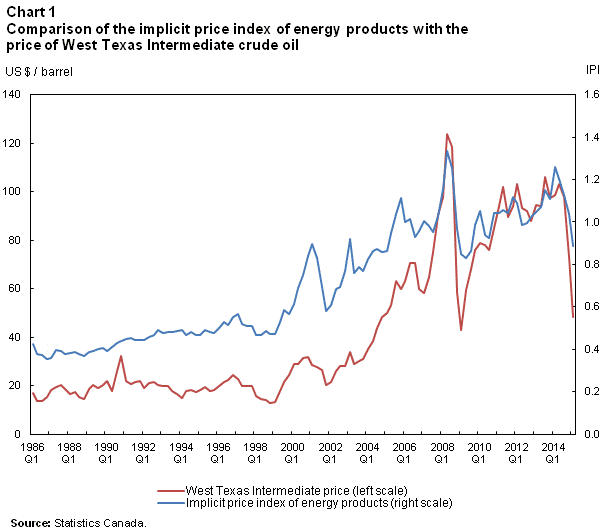Publications
Income and Expenditure Accounts Technical Series
Gross Domestic Product Excluding Expenditures on Energy Related Products
Gross Domestic Product Excluding Expenditures on Energy Related Products
Archived Content
Information identified as archived is provided for reference, research or recordkeeping purposes. It is not subject to the Government of Canada Web Standards and has not been altered or updated since it was archived. Please "contact us" to request a format other than those available.

This article provides an estimate of Gross Domestic Product (GDP) excluding expenditure on energy related products and compares it to total GDP.
Methodology and limitations
In this article, measures of GDP excluding expenditures on energy products and a measure of GDP reflecting expenditures on energy products are introduced. GDP reflecting expenditure on energy products includes the following expenditure categories: household final consumption of electricity, gas and other fuels, as well as motor fuels and lubricants, and net exports (exports minus imports) of energy products (crude oil and crude bitumen; natural gas, natural gas liquids and related products; refined petroleum energy products; electricity; other energy products).
This aggregate is a good indicator of the importance of expenditures on energy products to the Canadian economy but it should not be confused with the full impact that changes in energy prices and production have on the Canadian economy. It simply provides a picture of the trend in expenditures on energy related goods and services and non-energy related goods and services.
Since their recent peak in June 2014, oil prices have lost more than half their value.Note 1 This dramatic drop affects everyone. Expenditures on energy related products represent a large share of household budgets and account for a large part of the production costs of businesses and governments. Similarly, they constitute a significant share of Canadian imports and exports.
| Period | Real GDP | Real GDP excluding energy products | Nominal GDP | Nominal GDP excluding energy products |
|---|---|---|---|---|
| percent | ||||
| 1981 to 2014 | 2.4 | 2.4 | 5.2 | 5.1 |
| 1981 to 2009 | 2.4 | 2.4 | 5.3 | 5.2 |
| 2010 to 2014 | 2.3 | 1.9 | 4.4 | 3.8 |
| 2014 Q1 | 1.0 | 0.4 | 6.6 | 1.5 |
| 2014 Q2 | 3.4 | 2.6 | 3.8 | 4.9 |
| 2014 Q3 | 3.2 | 3.6 | 4.4 | 7.3 |
| 2014 Q4 | 2.2 | 2.5 | 0.4 | 3.5 |
| 2015 Q1 | -0.6 | -0.8 | -2.9 | 1.3 |
| Source: Statistics Canada. | ||||
Drop in oil prices felt in first quarter of 2015
In nominal terms, expenditures on energy products declined significantly in the first quarter of 2015. Both falling crude oil prices and decreased drilling activity contributed to the decline in the value of crude oil exports. In the first quarter of 2015 total nominal GDP fell 0.7% while nominal GDP excluding expenditure on energy products increased 0.3%.

As well, the decline in crude oil prices led to a drop in fuel prices at the pump. For example, the price of regular gasoline decreased 21.4%, when comparing the average price in the first quarter of 2015 with that in the first quarter of 2014. Although this decrease resulted in a drop in nominal expenditures, real expenditures were up for the quarter, even though fuel demand is relatively inelastic.
The decline in oil prices had limited impact on the consumption of electricity, gas and other fuels. During the first quarter, two conflicting forces influenced the price of electricity. First, the decline in oil prices made it possible for power plants to reduce production costs and lower prices. Second, strong demand due to a particularly cold winter in central Canada exerted upward pressure on the price of electricity.
The picture is quite different when removing the impact of the energy prices. In the first quarter of 2015, total real GDP decreased 0.1%. Real GDP excluding expenditure on energy products decreased at roughly the same rate (-0.2%).

After posting more or less identical average annual growth from 1981 to 2009, the total real GDP grew faster than the real GDP excluding energy products between 2010 and 2014.
However, the situation reversed during the second half of 2014. The nominal GDP excluding energy products posted a greater rate of growth than that of the total nominal GDP from the second quarter of 2014.
Trends since 1981
Expenditure on total energy products more than doubled in volume between the first quarter of 1981 (53.9 billion chained (2007) dollars) and the fourth quarter of 2014 (143.1 billion chained (2007) dollars). Their growth has accelerated since the first quarter of 2010, coinciding with a rise in crude oil prices and the use of new extraction technologies (such as hydraulic fracturing and horizontal drilling).

In real terms, there was an upward trend in net exports of energy products, in particular exports of crude oil, between the first quarter of 1981 and the fourth quarter of 2014. As well, household consumption of electricity, gas and other fuels, and of motor fuels and lubricants remained essentially unchanged during the same period.
In conclusion, this paper presents a measure of GDP excluding expenditure on energy products. This new measure is intended to provide users with insight into the underlying trend of non-energy expenditures by isolating and removing the sometimes volatile energy component.
Note
- Date modified:
